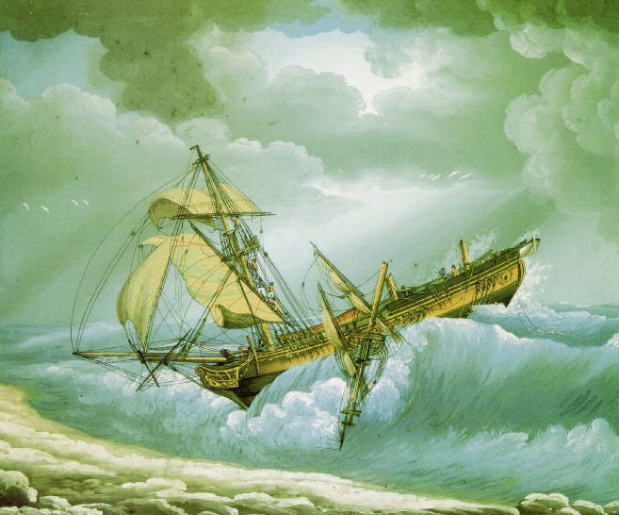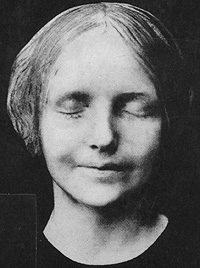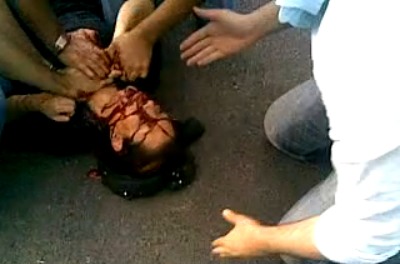Keep your eye on the ball, baby.
[Post cover by Dick Sargent]

Keep your eye on the ball, baby.
[Post cover by Dick Sargent]
This painting by Bouguereau, from 1881, is owned by the Forest Lawn Cemetery in Glendale, California, just over the hill from Hollywood. In 2005 it went up to the Getty Museum in Santa Monica on an extended loan in return for restoration, which primarily involved removing a coat of varnish that had yellowed, muting the original colors. The scan above records the restored work and comes by way of the always amazing Art Renewal Center.
I'm not sure whether or not the painting has gone back to Forest Lawn, but if you live in the Los Angeles area you're within striking distance of it, either way. If I lived in the Los Angeles area, I go see it immediately.
It's said that you either worship Bouguereau or you despise him — folks on either end of the spectrum tend to be a bit dogmatic on the subject. Anti-Modernists are inclined to place him in the Pantheon of the old masters, which seems extreme. I think Bouguereau is a great painter of the second or third rank, assuming, for example, that Jan Van Eyck is a painter of the first rank. Anti-Victorians are inclined to dismiss him out of hand as the embodiment of kitsch, which I think is even sillier.
The important thing is that his works are wonderful, in a very odd and original way. You can enjoy them immensely without worshiping them and you can recognize their limitations without despising them.
Folks who don't live in the New York City area might not know about the High Line — a stretch of elevated railroad tracks in lower Manhattan. It used to carry freight trains into Manhattan terminals but stood abandoned for years and attained a kind of mythical status, because it became overgrown with vegetation and constituted a bit of wilderness in the middle of the city. It was officially inaccessible but became familiar through photographs taken of it and the stories of people who sneaked up to have a look at it themselves.
The basic structure has remained sound and a campaign was launched to turn it into a park — a very odd park. The park opened this month and my friend Jae Song, a resident of Brooklyn, went to see it. He sends the following report of his initial impressions, illustrated with photos he took, mostly using the panorama mode on his cell-phone camera:
Went to visit the High Line.
For crowd control on opening day they set up a rule — you could only enter from one end and exit at the other. Even
though it wasn't opening day when I visited, and there was hardly anyone there, when I tried to go up the “exit” stairs there was some fascist
telling me I had to walk down to the entrance at the other end. (Why
can't people just think on their own? Why do they have to follow strict
rules without knowing what the rules are for?)
This should have tipped me off as to what I was about to experience . . .
At first — it was exciting to be able to go up to those old tracks that have been closed off for so long.
And it was really . . . nice.
A very well designed place.

There are benches that rise up from the ground in sleek fashion. There are big lounge chairs made of dark wood. There's a space with auditorium seating that looks out over 10th Avenue.

The palette is modern grey and dark brown
. . . with weeds carefully placed growing in patches here and there.
Everything is very well thought out and all . . . perfect.
I walked all the way to the far end and then went back to the middle and took a seat on one of the lounge chairs.
And as I sat there . . . I became incredibly sad.
The High Line is like one of those beautiful old historic factories that is converted into a clean modern luxury loft.
The modern sleekness has cleaned all emotion from the place. No mystery — no possibilities.
It's all too perfectly designed, too purposefully placed . . . everything —
every “haphazard” weed, every loose pebble. Even the concrete slabs on
the ground have perfectly placed irregularities. All of it makes it
impossible for me to make the space . . . my space. I can't connect with
it personally.
I can't do anything in the space that the architects and designers haven't already prepared for.
I feel controlled by whatever corporation it was that took it
over. The planners obviously wanted to keep the feel of the old High Line — but the old High Line was an iron
industrial structure that nature took over, in unpredictable ways. There's nothing unpredictable about it now.
It's like watching an M. Night Shyamalan movie. It is very well crafted — I
can't fault him for not making a very well-constructed movie — but most
of the time I don't really feel anything, and the movie has very little
life. It's not that I don't like the movie, it's that I feel I'm supposed to like it, I'm supposed to feel a certain way, but I don't, and I want to feel something but I don't . . . and that pisses me
off.
Unlike watching a Godard film. It's sloppy as hell but so exciting, and it makes me giggle, and sometimes I'm glued to the screen and I
don't even know why . . . I don't know what the hell's going on.
Why is there this need to make beautiful old things into clean
sterile piles of nothing? Do they make yuppies feel safe? Because they
don't have to think — they go, they know what they are suppose to do,
they do it, they post pics online, they check it off on their
experience list.
Why can't something just be, age and become whatever it is it is
becoming? What's with face lifts and boob jobs? What's with “luxury”
condos? What's with the High Line! Another place for people to make
money now I suppose. (There are bars and restaurants opening up all
over the neighborhoods near the High Line, and up on the High Line, too.) Personally I like a really nicely aged
steak rather than a fresh cut.
It is so sad to me . . . yet another thing in New York that has come to ruin . . .
Jae has made subsequent visits to the High Line and modified his opinion of it somewhat. New Yorkers are appropriating it and making it their own. That's what New Yorkers always do. When Central Park opened in 1873 one of its designers, Frederick Law Olmstead, wanted visitors to use it exactly as he imagined it being used — strolling its paths in a civilized manner, serenely admiring his vision of nature. He didn't want bars or bandstands or ball fields — anything that might attract or appeal to the baser natures of the great unwashed.
That didn't last long.
So there's hope for the High Line, too. Perhaps Jae will write a follow-up report on the progress of its re-incorporation . . . as a people's park.
[All photos © 2009 Jae Song]
From the 1950s, I think. Very cool. Paris swings, but old lady Seine . . . she just keeps rolling along.
I can't remember where I found this or who took it. If anybody out there knows, I'll be happy to give credit where credit is due.
In 1972, when I was 22 years-old, I crossed the Atlantic for the first time, to London, where my sister was living at the time. I went with the rest of my family, including my grandmother, and my friend Cotty Chubb. We stayed in a rented house near Hampstead Heath.
We arrived at night and first thing the next morning Cotty and I headed straight to Bunhill Fields by the Underground. We would have taken the Edgeware-Morden line from Hampstead to the Old Street station, which is just a short walk from Bunhill Fields. At one end of the journey or the other we found a florist and bought three yellow roses to lay on the grave of William Blake, who is buried in Bunhill Fields with other dissenters from the Church Of England orthodoxy.
In 1965 many of the grave markers in Bunhill Fields (whose name is derived from Bonehill Fields) had been removed to create a small park with a lawn — the “fields” of old have become a very small bit of enclosed space. Blake's grave had been unmarked until 1927, when a small stone was erected over it. In 1965 the stone, which lay within the area of the planned park, was moved to a location near the intersection of two paved pathways, which is where we found it and where it remains today, about 20 yards from Blake's actual resting place, in a once-again unmarked spot on the present lawn. (Recently the actual gravesite was re-discovered and there are plans afoot to put a new marker there.)
We laid the roses on the pathway in front of the marker we found. “One for me,” I said, “one for thee, and one for you know who.” I wasn't quite sure what this meant, but it allows me to say today that I laid a rose on Blake's grave for you, whoever you are.
Cotty and I visited several other Blake sites in London, and took a train down to Felpham, on the south coast of England, to see the cottage where Blake lived for a few years and where he wrote Jerusalem.
From the train station in Felpham we took an enclosed double-decker bus to the cottage. It was just before Christmas. In the front seat of the second deck of the bus was a little girl of about 5 years of age, sitting with her mother. The little girl was singing, in a sweet, piping voice, “Hark, the Herald Angels Sing!”
I'm quite sure that Mr. Blake arranged this — perhaps to thank us for the flowers.
Demons drove him hence. He was a beautiful young man who somehow got the notion that he was meant to look like Lena Horne. He paid doctors to hack away at his face until it bore a grotesque resemblance to his dream. It was reported that in recent years the surgery had caused his nose to collapse, requiring the use of a prosthetic device to hide the horror of it. Poe alone could have dealt with the American Gothic tragedy of Michael Jackson's life — the life of a man who made and wore his own death mask.

The root of it was probably all too simple — the usual dad thing. It's been related that Michael's dad, when Michael was a kid about to go on stage, used to tell him there were men with guns in the audience who would shoot him if he didn't dance fast enough. He's been dancing fast ever since. From childhood he was surround by crowds of people who couldn't say no to him — all of which was nothing as against a father who couldn't say yes.
He really was the King Of Pop, though — even if that was a title he first bestowed on himself. Great pop music can unite generations and classes and races in its infectious magic. As the tributes pile up on the cable news shows, Michael's music plays them in and out. Almost all of it makes you want to dance — and makes you sad that Michael was dancing to a different beat in his head when he made it . . . the beat of a death march that has finally reached the burying ground.
All that wonderful music we heard in its place was perhaps another illustration of The Nazareth Principle.
In my last post I goofed on all the conflicting stories surrounding the mystery of Governor Mark Sanford's whereabouts. Little did I know that the truth behind the incident would prove more surreal than I could possibly have imagined. The guy was “hiking the Appalachian Trail” down in Argentina, of all places, and having himself a good cry in the bargain.
I don't mean to be too flip about it, though. If you watched the poor fellow's press conference you basically saw someone having a nervous breakdown on national television. Sanford strikes me as a different sort of man from John Ensign, whose adultery and contrition over same seemed purely cynical, and which I parodied in an earlier post. Ensign doubled his mistress's salary while they were sleeping together, then fired her when the affair was over. His “backstreet romance” was more like transactional sex — like prostitution.
I see Ensign as one of those politicians who enjoy using the law to force their morality on others but feel no corresponding obligation to live up to that morality themselves. This is less about hypocrisy or ordinary human frailty than about pathological arrogance. Eliot Spitzer, on the other side of the political spectrum, seemed to suffer from the same syndrome — relentlessly prosecuting prostitution in courts of law while employing the “services” of a prostitute in private.
John Edwards, by contrast, didn't pontificate about other people's morality — his adultery seemed to proceed from narcissism of an extremely advanced variety.
Sanford's case feels more complex, and interesting. He's clearly still in love with his Argentinian bombshell, if by love we mean the pussy-fever associated with a new and transgressive sexual relationship. Some failing in the right-wing Christian culture he inhabits seems to have left him unprepared to deal with the power of that fever — you get a sense he was blindsided by it, and is still reeling from the blow.
Perhaps there is something about the rhetoric of his culture that minimizes the exaltation of sexual love, relating it too exclusively to law and duty, downplaying its delirious joy, leaving the members of that culture defenseless when the real thing emerges or re-emerges in their lives.

When it comes to adultery, I'm agin' it — I don't see it as a “pecadillo” but as a profound, existentially crippling moral failing . . . yet at the same time less about the sex involved than about a violation of trust that can almost literally rip the heart out of a partner. No amount of personal pleasure or fulfillment can justify it, but you need to have a healthy appreciation of just how much personal pleasure and fulfillment it can deliver to know what you're up against when it presents itself.
I don't think Mark Sanford had a clue. In his e-mails to his mistress he sounds like a lovesick and somewhat bewildered teenager. How did he get to the age of 49 in that condition of emotional immaturity?
I'd like to apologize to the readers of this blog for my unexplained absence between the 16th and 18th of this month, when nothing was posted here. The truth is that I went off hiking by myself in the Red Rock National Conservation Area, just outside Las Vegas — because I needed some space to clear my head.
While in Mexico, I was able to put things back into focus, reorder my priorities and set ambitious new goals for the future.

There's just something about the pure air of the Canadian Rockies that sharpens a fellow's perspective. Up in that high country, far above the worries of the world, I was lucky enough to run into my old friend Mark Sanford, Governor of South Carolina, who was having a little “time out” of his own. We fished for trout in a sparkling brook, cooked up our catch over a crackling fire under the stars and commiserated about our crushing responsibilities.

It helped, I can tell you. As we brought our little boat about in a brisk gale in the Bay Of Biscay and headed towards the shelter of the harbor at Santander, we felt ready to resume our burdens.
I know people were worried about me while I was gone — the Gobi Desert isn't a place you want to wander in for too long on your own — but I'm back, I'm fine, and I feel renewed. When Mark gets home, I'm sure he'll have a very similar tale to tell.
What's happening in Iran right now makes me ashamed that I didn't take to the streets in 2000, along with hundreds of thousands of other Americans, when the Supreme Court appointed George Bush President, in lieu of counting all the votes actually cast in the election — the most disgraceful act committed by that august body since the Dred Scott decision of 1857.
All Americans should have been willing to die rather than accept the selection of its leader by a small group of “wise elders” rather than the election of that leader by the votes of the people. We lost an incalculable measure of our honor as citizens of a great republic when we failed to respond to the Supreme Court's grotesque violation of the Constitution.
The people of Iran, especially its courageous young women, put us all to shame, and make us realize that we richly deserved our Ahmadinejad — “the mullahs's choice”.
My sister Neda — and yours. Murdered by the Iranian state on the streets of Tehran this past Saturday.
Folks who use Twitter are encouraged to set their Twitter time zone to Tehran time — in the Settings menu — to help disguise Tweets originating in Iran from the Iranian government.
The coverage of the events in Iran by the cable news networks has been disgraceful. They basically just report online news several hours after it appears on the Internet, jazzed up with meaningless bloviation.
The deluge of Tweets on the subject is confusing, however. Here's a site which filters them intelligently (something the official news organizations seem incapable of doing):
Super-filtered #IranElection info for the easily overwhelmed (like CNN).

Do you know about her?
The story goes like this . . .
In the 1880s the corpse of a young girl was found floating in the
Seine. The body showed no marks of violence, so it was assumed the
girl committed suicide. She was never identified.
Apparently
a doctor working in the Paris morgue was so taken by her beauty that he
made a death mask of her face. Somehow copies of the death mask
started circulating — Romantic artists in particular fell in love with
it and hung it on the walls of their studios. When people couldn't get
copies of the cast they settled for photographs of it, and some artists
even made new sculptures based on the photographs. It became a cult
object. L'Inconnue de la Seine — the Unknown Girl of the Seine, as she
came to be called — was mentioned in a number of works of 20th Century
literature.
However . . .
. . . modern experts say
that the original cast could not possibly be a death mask, especially
one taken from a corpse which had spent any time in water, because it's
too detailed and the skin is too firm and full over the skull. They
say it was made from a living model, probably around sixteen years of
age.
The true model, like the original corpse, has never been identified.
André
Bazin said that a film image has the same relationship to the reality
it records that a death mask has to the face of the corpse it's taken
from — a kind of shared “identity” based on a strict point to point
correspondence. Glamorizing a dead girl by worshiping a cast of her
face may seem like a Victorian eccentricity — but in our time we
worship the images of long-dead movie stars in just the same way. The
photographic “casts” of their faces and forms, in motion no less, still
have glamor . . . and it's partly the glamor of loss, of death.
The “death mask” of L'Inconnue de la Seine had a certain false piquance
supplied by the fact that it was, in fact, a life mask. (“So alive — even in death!”) It's a
different kind of object in our time, because the living girl whose
face it reproduced has long since died. But she was a star in her time
— and remains one, like Judy Garland, Marilyn Monroe . . . and, in her own more sublime and serious way, Neda.

The unarmed woman in the picture above was shot dead on the streets of Tehran today. She was apparently standing off to the side with her father watching the protests when she was shot through the chest by a member of the official “militia” on a nearby rooftop. I wonder how this brave and devout fellow is sleeping tonight. I wonder how the sick, wicked old men who unleashed this horror are sleeping tonight.
It has been reported that the name of the murdered women is Neda — which is Farsi for “voice”. It has not been silenced. Her name has flown around the world on the Internet with the speed of angels in flight. Pictures of her bloody face have been taken up by the protesters in Iran as a symbol of their rising.
I'm sorry to post it here — I know it's hard to look at — but it helps me realize that the hands reaching down to save her must be our hands, too. We are all Iranians now. An anonymous Tweet from someone in Iran:
I had one vote. I gave it to Mousavi. I have one life. I will give it for freedom.
In terrible moments like this we realize how important and powerful one life can be.
Mousavi says he is ready for martyrdom. Will the sick, wicked old men demand that of him? If so, they will join the dust heap of history far quicker and far sooner than anyone could have imagined ten days ago.

A protester on the streets of Iran this week holding up a hand puppet with a sign that reads:
Real face of a liar dictator.
If you're the praying sort, pray for those on the streets of Iran today. If not, keep your fingers crossed.
John Ensign is one of my Senators here in the great state of Nevada. For years he's been speaking out forcefully against the legal recognition of same-sex unions, on the grounds that it represents a threat to the sanctity of traditional marriage.
Some might say that he has pontificated self-righteously on the subject, but you have to understand that John saw legal same-sex unions as a clear and present danger to the very foundations of human civilization.
Recent events have tended to confirm his view beyond a reasonable doubt.
When John heard that Vermont, Maine and Iowa (of all places!) had recognized same-sex unions he immediately began fucking someone who was not his his wife. Who can blame him? If two fags in Iowa could get the same civil benefits of marriage that used to be reserved for heterosexual couples exclusively, what possible motivation remained for John to honor the sanctity of his own marriage vows?
Vermont, Maine, Iowa — please, in the name of all that's holy! Repeal your laws recognizing same-sex unions now and help save John Ensign's marriage before it's too late!

John is not a bad person. He's stepped up to the plate, taken responsibility and expressed contrition for his actions. All it took for him to do this was a threat of blackmail. If rumors of other “indiscretions” prove to be true, I'm sure he'll express the same contrition for each of them — all in good time . . . just as soon as the gentle prod of blackmail is applied.
Meanwhile . . . for shame, Iowa — for shame!
Awkward dating moments do seem to occur more often when extraterrestrial aliens woo earthlings. A little more understanding on both sides is what's needed.